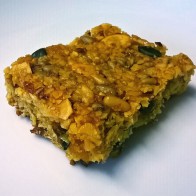Many people find flapjacks a good on-the-go snack when they need energy fast and they serve that purpose well. However, a standard flapjack recipe will contain nearly 40% sugar. This recipe shows how to cut down on some of the extrinsic sugar found in one of the nations favourite (seemingly healthy) snacks.
Extrinsic vs Intrinsic Sugars (a very brief overview)
Nearly all of the sugar in a standard flapjack with be extrinsic: sugar added to foods that is not bound up in the structure of a food. In reverse, intrinsic sugar is found bedded into the structure or cells of foods like fruit and vegetables. Foods higher in intrinsic sugars are likely to have a lower Glyceamic Index meaning that the energy those sugars provide is released more slowly as the food is digested. Excessive extrinsic or added sugars are likely to spike your blood glucose levels leaving you less energised later on, sometimes craving more sugar and if you do not burn off the calories they provide, likely to be stored as fat quicker than intrinsic sugars. Both types of sugar are also linked with increased tooth enamel decay as plaque bacteria in the mouth ferments these sugars to produce acid.
Sugar is not only linked with what might seem like the obvious health issues like obesity and dental health but also has a wider impact as described in my post on 2015 Diet Trends. Therefore, it is probably wise that we all reduce the amount of sugar we’re eating; it’s everywhere, but it can be difficult to cut it out all together. So why not try cutting down on your extrinsic (added or “free”) sugars with this recipe for a hearty snack or on-the-go breakfast?
Fruit, Seed and Nut Flapjacks
Nutritional content as compared to a Graze “Fruit and Seed Flapjack” of the same weight:
| Our recipe | Graze | |
| Calories | 158 | 225 |
| Fat | 11.9g | 11g |
| Saturated fat | 3.4 | 3.5g |
| Sugar | 11.3 | 19g |
Look similar don’t they? Most of the fat in this recipe actually comes from the nuts and the seeds which provide mono and poly-unsaturated fats as well as protein. The sugar in this recipe is mostly intrinsic too rather than extrinsic from the addition of sugar or golden syrup as in the Graze product.
Makes 16 portions
Can be made with whatever dried fruit, nuts and seed you have lying around. Instead of using sugar to make a sticky gloop that binds the oats togeher, we use pureed fruit.
- 200g oats (gluten free if possible)
- 150g low fat margarine or dairy-free spread
- 2 tbsp honey (essential for binding it all together)
- 100g dried fruit like sultanas or dates
- 50g mixed seeds
- 75g mixed nuts
- 150g apricots
- 5 tbsp water
- Preheat an oven to 180C and line a standard (26cm x 19cm), deep baking tray with greaseproof paper.
- Place the nuts in a food processor and blitz to chop up the nuts. You can do this by hand if you like but you want them quite small. Pop in a large mixing bowl.
- Place the dried fruit and 50g of the apricots in a small saucepan with the water and honey. Heat to soften the fruit, a few minutes.
- Place in the food processor and blitz until smooth.
- Melt the margarine in the same saucepan and when melted, add the fruit puree back in and mix well.
- Add the rest of the dry ingredients to the bowl and chop up the remaining apricots into small pieces. Add these to the bowl.
- Combine the wet and dry ingredients and mix well until everything is coated with the margarine and fruit.
- Press into the baking tray firmly and make sure it is even.
- Bake for 25 minutes until lightly browned at the edge.
- Leave to cool in the tray. It may seem a bit crumbly at first but once cool, it will hold together.
- Slice into 16 chunks and enjoy for up to 10 days in a sealed container.

